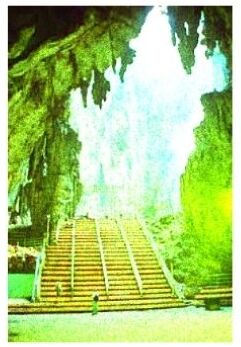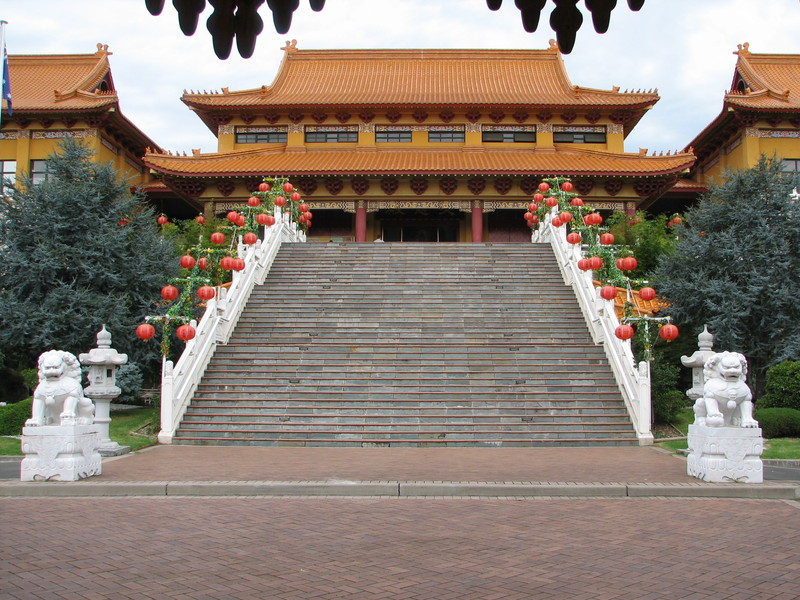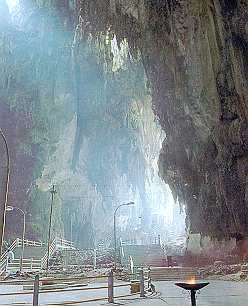|
++KL SIGHTS++ |
||
| » Selamat Datang ke Kuala Lumpur » Things to See in Kuala Lumpur (A-Z): Aquaria KLCC » Batu Caves » Chinatown » Kuala Lumpur Bird Park » Little India » Pudu Prison » Twin Towers » Things to Eat in Kuala Lumpur: Fish Head Curry and More » Places to Party in Kuala Lumpur: Clubs and Bars » Places to Shop in Kuala Lumpur: Suria KLCC » Kuala Lumpur Hotels (Courtesy of Hotel Travel) » Getting Around Kuala Lumpur: Kuala Lumpur Street Atlas Map » Getting There: Kuala Lumpur Airport » Social Issue: Are Jews Welcome in Malaysia? » Malaysia for Indian Tourists » Learning Basic Travel Bahasa Malaysia 
 Nan Tien Buddhist Sanctuary, Wollongong, Australia
|
ONE OF THE MOST ATMOSPHERIC AND MOODY PLACES YOU CAN SEE ON THE MALAY PENINSULA IS JUST 13 KILOMETERS OUT OF KUALA LUMPUR -- I am referring of course to the Tamil-style Hindu temple complex at Batu Caves. You just have to see the photo on the blue bar on the left-hand side of this page to see how moody and how sublimely Hindu and deliciously Asian this temple is -- this is the kind of scene they used to paint on vases back in the days of Ancient China! I can't think of an image more mystic and mistily Asian than this image, and it is only an indication of the kind of mysticism which seeps throughout the three main caves and smaller holes at Batu. Mystic energy pours out of the Batu Caves like sweat from the pores of the skin. If you go there, you will understand. This place has energy.
In case you haven't been there yet, try to picture it this way: one of the caves (the Temple Cave) features a vaulted ceiling about 100 metres above the floor. To reach it one has to climb 272 steps, a feat performed by many Hindus on the way to the caves to offer prayers to their revered deities. Every year, on Thaipusam, as many as 800,000 devotees and other visitors may throng the caves. As a form of penance or sacrifice, many of them carry kavadis. These are large, brightly decorated frameworks, usually combined with various metal hooks and skewers which are used to pierce the skin, cheeks and tongue. You can imagine the pain these guys go through! But it doesn't matter, they don't feel it, because they are so swept up in ecstasy for their god, and for the wonder and glory of the place they call Batu Caves.
One web user, Mobius, was lucky enough to visit the Batu Caves during festival time and had this to say about the experience:
 Thaipusam has a number of meanings for Hindus, with the most spectacular and visible one being those that come to do penance for misdeeds or being unworthy of their gods. This penance takes the form of what look like incredibly masochistic feats of atonement such as seeing the endless procession of men who have attached limes, oranges or small silver urns to their backs and chests with hooks directly into their skin! Some add to this by attaching these hooks to rope which would be held by family members providing resistance and keeping these ropes taut against the devotee straining against it. Others wear enormous 'kavadi's' (meaning "suffering at every step"), which are basically ornately decorated shrines assembled upon a steel frame that is supported around the bearers waist. Many of these kavidis weigh from 100-150 lbs and upwards and also have to be manhandled up the steps into the temple above. Not all worship involves self inflicted pain, and many men and women make the walk to the Caves barefooted with a simple silver urn of fresh milk on their head in thanks for any children born that year. This was without doubt one of the most spiritual experiences I have ever had and I was so glad to be a part of it. Thaipusam has a number of meanings for Hindus, with the most spectacular and visible one being those that come to do penance for misdeeds or being unworthy of their gods. This penance takes the form of what look like incredibly masochistic feats of atonement such as seeing the endless procession of men who have attached limes, oranges or small silver urns to their backs and chests with hooks directly into their skin! Some add to this by attaching these hooks to rope which would be held by family members providing resistance and keeping these ropes taut against the devotee straining against it. Others wear enormous 'kavadi's' (meaning "suffering at every step"), which are basically ornately decorated shrines assembled upon a steel frame that is supported around the bearers waist. Many of these kavidis weigh from 100-150 lbs and upwards and also have to be manhandled up the steps into the temple above. Not all worship involves self inflicted pain, and many men and women make the walk to the Caves barefooted with a simple silver urn of fresh milk on their head in thanks for any children born that year. This was without doubt one of the most spiritual experiences I have ever had and I was so glad to be a part of it.A little below the Temple Cave is the Dark Cave, a two-kilometre long network of relatively untouched caverns containing a large number of cave animals, including several found nowhere else in the world! Access to this cave is restricted and permission and guidelines must be obtained from the Malaysian Nature Society. At the foot of the steps is the art Gallery Cave, in which are displayed statues and wall paintings depicting Hindu mythology. Access is via a concrete walkway spanning a small lake and nominal entrance fee is charged.
a r t + g a l l e r y THE CAVE ART GALLERY IS CONSIDERED BY MANY THE FINEST THING TO SEE AT BATU -- it really is somehting. The gallery is dedicated to Valluvar, a poet saint who was born in Mayilaapur in Tamil Nadu State, India, about 2000 years ago. Consequently, the gallery is known as the Valluvar Kottam. Valluvar's poems are maxims and homilies to guide human beings in the proper conduct of their lives. The poems, 1,330 pithy couplets called the Tirukkural, are filled with sagely wisdom meaningfully consistent with all times. Overseas Tamil Indians have designated the Tirukkural as their "holy scripture" equivalent to holy books of other religions. The cave walls of the Valluvar Kottam are covered with statuary exhibits, murals and inscriptions of the poet's couplets. The cave costs 1RM to enter.
n e a r b y + f a c i l i t i e s MORE IN DEPTH INFORMATION ON PUBLIC SERVICES, BANKS, DOCTORS AND MEDICAL SERVICES AND SO ON TO BE FOUND AROUND BATU CAVES: Public Bank Berhad: 45-49 Jalan 2/3A Pusat Bandar, Utara Selayang, 68100, Batu Caves. Phone: 03/6136 8644, 03/6136 8645.
g e t t i n g + t h e r e TWO MAIN WAYS TO GET THERE -- bus or taxi. Local buses to Batu Caves can be boarded at the Pudu Raya Bus Terminal in Kuala Lumpur. A taxi shouldn't cost too much because Malaysia is generally not an expensive country in general, and the caves are not so far from Kuala Lumpur. Classifieds | Hindu Saints | Horoscopes | Forum | Kuala Lumpur Sights | Jobs | Maps | Medicine | Movies | Palmistry | Real Estate | Restaurants & Bars | Study in Malaysia | Yoga | |
|
| ||

